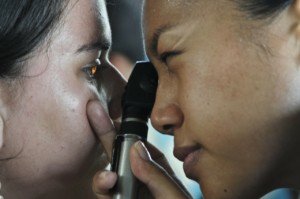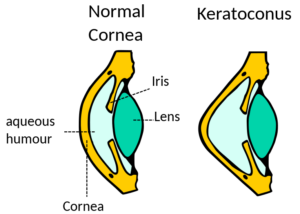What is Astigmatism?
Astigmatism is a common vision problem which is caused by an error in the shape of the cornea.
Astigmatism occurs when the front surface of the eye which is the cornea or the lens of your eye has an irregular curve.
This irregular curve tends to change the way that the light refracts or passes to your retina. This tends to cause distorted, blurry and fuzzy vision.
Nearsightedness and farsightedness are two other types of problems that occur due to the way that light passes to your retina. Nearsightedness is also known as myopia.
Farsightedness is known as hyperopia. It is best to diagnose astigmatism before it gets out of control.
Five Astigmatism Symptoms
- Blurred Vision
Regular blurry vision is a symptom of astigmatism. Don’t get fooled into thinking that you have blurry vision due to eyestrain or fatigue, as it is a major sign of astigmatism.
- Headaches
If you suffer from regular and constant headaches for no apparent reason then it is best that you consult your ophthalmologist, as this can lead to migraines which can lead to more serious problems if not taken care of in time.
- Excessive Squinting
If you find yourself squinting excessively and struggle with focusing on any printed words and lines.
- Eye Strain and Irritation
If your eyes are constantly strained and irritated then it is best to go visit your ophthalmologist, as this can lead to more adverse problems if not taken care of in time.
- Difficulty Driving at Night
If you have difficulty in driving at night then you should immediately visit your ophthalmologist, as this is very risky and can directly threaten your life. Avoid driving at night at all costs till you consult your ophthalmologist.
Who is at Risk for Astigmatism?
Astigmatism can occur in both adults and children. You stand a much higher chance of developing astigmatism if you suffer from any of the following:
- If you already have a history of particular types of eye surgery such as cataract surgery
- Severe farsightedness which leads to blurry close-up vision
- Severe nearsightedness which leads to blurry vision from a distance
- Thinning or scarring of your cornea
- If you have a family history of astigmatism and any other eye disorders
What Causes Astigmatism?
• The curve of your cornea and lens tends to bend the light which enters the eye to help it focus exactly on the retina at the back of your eye.
The surface of the cornea tends to have a different type of curvature when you have astigmatism.
• The surface of your cornea is usually in a round shape like a basketball, whereas in the case of astigmatism it is shaped more like a football instead, which makes it more difficult for your eye to focus the light rays entering it, making your vision blurry from any distance.
• The curvature of the lens inside your eye can change as well over time which can lead to a decrease or an increase in astigmatism.
This change usually tends to occur in adulthood though and usually precedes the development of naturally occurring cataracts.
• Astigmatism can also sometimes develop after an eye injury.
• Astigmatism can also occur due to a rare condition known as keratoconus whereby the cornea becomes thinner and cone-shaped.
• This leads to a lot of astigmatism which leads to poor vision which can’t be clearly corrected with eyeglasses.
People who have keratoconus usually tend to need contact lenses for clear vision and may eventually need a corneal transplant.
Cure for Astigmatism
Mild cases of astigmatism usually don’t require any treatment. Your ophthalmologist may suggest treating astigmatism that causes vision problems by using one of the following methods:
- Corrective Lenses
Corrective lenses are designed to bend light rays in a way that compensates for the error caused by faulty refraction which enables images to be accurately projected onto your retina.
Contact lenses or glasses are usually used to help in correcting your vision. A normal prescription for near- or farsightedness includes sphere power, to correct the vision.
Glasses may be better suited for young children who are under the age of 12 though. You need to maintain good lens hygiene to reduce the chances of infections as well.
- LASIK for Astigmatism
Astigmatism can be corrected by reshaping the cornea with LASIK or PRK.
LASIK is designed to remove tissue only from the inner layer of the cornea, whereas PRK tends to remove tissue from the superficial and inner layers of the cornea.










































